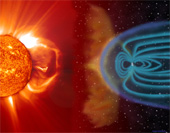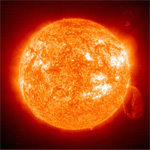
|
Solar News 2008
January 2007 December · November · October · September · August · July · June · May · April · March · February · More... June 21, 2007  ASU Geophysicists Detect Molten Rock Layer Deep Below American Southwest (ASU Insight) A
sheet of molten rock roughly 10 miles thick spreads underneath
much of the American Southwest, some 250 miles below Tucson. From
the surface, you can't see it, smell it or feel it. Image Credit: NASA-MSFC June 19, 2007  Mysteries of Light (Washington Post) For
Centuries, Man Has Yearned to Understand the Power of the Sun.
Now Area Scientists Are Working to Harness It. Image Credit: SOHO (ESA & NASA) |